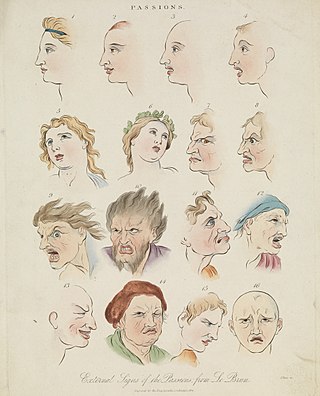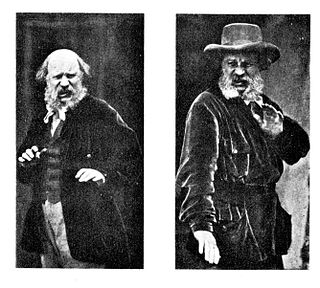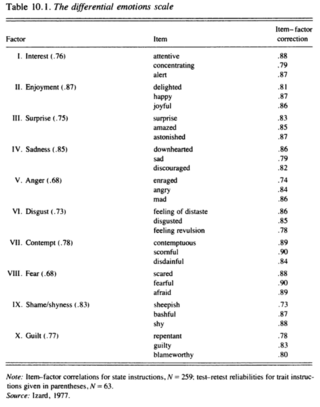Related Research Articles

Emotions are mental states brought on by neurophysiological changes, variously associated with thoughts, feelings, behavioral responses, and a degree of pleasure or displeasure. There is currently no scientific consensus on a definition. Emotions are often intertwined with mood, temperament, personality, disposition, or creativity.
A facial expression is one or more motions or positions of the muscles beneath the skin of the face. According to one set of controversial theories, these movements convey the emotional state of an individual to observers. Facial expressions are a form of nonverbal communication. They are a primary means of conveying social information between humans, but they also occur in most other mammals and some other animal species.

Paul Ekman is an American psychologist and professor emeritus at the University of California, San Francisco who is a pioneer in the study of emotions and their relation to facial expressions. He was ranked 59th out of the 100 most cited psychologists of the twentieth century. Ekman conducted seminal research on the specific biological correlations of specific emotions, attempting to demonstrate the universality and discreteness of emotions in a Darwinian approach.
A microexpression is a facial expression that only lasts for a short moment. It is the innate result of a voluntary and an involuntary emotional response occurring simultaneously and conflicting with one another, and occurs when the amygdala responds appropriately to the stimuli that the individual experiences and the individual wishes to conceal this specific emotion. This results in the individual very briefly displaying their true emotions followed by a false emotional reaction.
Affect theory is a theory that seeks to organize affects, sometimes used interchangeably with emotions or subjectively experienced feelings, into discrete categories and to typify their physiological, social, interpersonal, and internalized manifestations. The conversation about affect theory has been taken up in psychology, psychoanalysis, neuroscience, medicine, interpersonal communication, literary theory, critical theory, media studies, and gender studies, among other fields. Hence, affect theory is defined in different ways, depending on the discipline.
An emotional expression is a behavior that communicates an emotional state or attitude. It can be verbal or nonverbal, and can occur with or without self-awareness. Emotional expressions include facial movements like smiling or scowling, simple behaviors like crying, laughing, or saying "thank you," and more complex behaviors like writing a letter or giving a gift. Individuals have some conscious control of their emotional expressions; however, they need not have conscious awareness of their emotional or affective state in order to express emotion.

A frown is a facial expression in which the eyebrows are brought together, and the forehead is wrinkled, usually indicating displeasure, sadness or worry, or less often confusion or concentration. The appearance of a frown varies by culture. An alternative usage in North America is thought of as an expression of the mouth. In those cases when used iconically, as with an emoticon, it is entirely presented by the curve of the lips forming a down-open curve. The mouth expression is also commonly referred to in the colloquial English phrase, especially in the United States, to "turn that frown upside down" which indicates changing from sad to happy.

Silvan Solomon Tomkins was a psychologist and personality theorist who developed both affect theory and script theory. Following the publication of the third volume of his book Affect Imagery Consciousness in 1991, his body of work received renewed interest, leading to attempts by others to summarize and popularize his theories.
The facial feedback hypothesis, rooted in the conjectures of Charles Darwin and William James, is that one's facial expression directly affects their emotional experience. Specifically, physiological activation of the facial regions associated with certain emotions holds a direct effect on the elicitation of such emotional states, and the lack of or inhibition of facial activation will result in the suppression of corresponding emotional states.
The theory of constructed emotion is a theory in affective science proposed by Lisa Feldman Barrett to explain the experience and perception of emotion. The theory posits that instances of emotion are constructed predictively by the brain in the moment as needed. It draws from social construction, psychological construction, and neuroconstruction.
According to some theories, emotions are universal phenomena, albeit affected by culture. Emotions are "internal phenomena that can, but do not always, make themselves observable through expression and behavior". While some emotions are universal and are experienced in similar ways as a reaction to similar events across all cultures, other emotions show considerable cultural differences in their antecedent events, the way they are experienced, the reactions they provoke and the way they are perceived by the surrounding society. According to other theories, termed social constructionist, emotions are more deeply culturally influenced. The components of emotions are universal, but the patterns are social constructions. Some also theorize that culture is affected by emotions of the people.
Carroll Ellis Izard was an American research psychologist known for his contributions to differential emotions theory (DET), and the Maximally Discriminative Affect Coding System (MAX) on which he worked with Paul Ekman. Izard also undertook empirical studies into the facial feedback hypothesis according to which emotions which have different functions also cause facial expressions which in turn provide us with cues about what emotion a person is feeling. In addition, Izard constructed a multidimensional self-report measure – the Differential Emotions Scale – currently in its 4th edition (DES-IV). His later research focused on emotional development in young children and the development and testing of his Emotions Course for Young Children.

Emotion classification, the means by which one may distinguish or contrast one emotion from another, is a contested issue in emotion research and in affective science. Researchers have approached the classification of emotions from one of two fundamental viewpoints:
- that emotions are discrete and fundamentally different constructs
- that emotions can be characterized on a dimensional basis in groupings
Affect consciousness refers to an individual's ability to consciously perceive, tolerate, reflect upon, and express affects. These four abilities are operationalized as degrees of awareness, tolerance, emotional (nonverbal) expression, and conceptual (verbal) expression of each of the following eleven affect categories:
Affect measures are used in the study of human affect, and refer to measures obtained from self-report studies asking participants to quantify their current feelings or average feelings over a longer period of time. Even though some affect measures contain variations that allow assessment of basic predispositions to experience a certain emotion, tests for such stable traits are usually considered to be personality tests.
The study of the evolution of emotions dates back to the 19th century. Evolution and natural selection has been applied to the study of human communication, mainly by Charles Darwin in his 1872 work, The Expression of the Emotions in Man and Animals. Darwin researched the expression of emotions in an effort to support his materialist theory of unguided evolution. He proposed that much like other traits found in animals, emotions apparently also evolved and were adapted over time. His work looked at not only facial expressions in animals and specifically humans, but attempted to point out parallels between behaviors in humans and other animals.

Disgust is an emotional response of rejection or revulsion to something potentially contagious or something considered offensive, distasteful or unpleasant. In The Expression of the Emotions in Man and Animals, Charles Darwin wrote that disgust is a sensation that refers to something revolting. Disgust is experienced primarily in relation to the sense of taste, and secondarily to anything which causes a similar feeling by sense of smell, touch, or vision. Musically sensitive people may even be disgusted by the cacophony of inharmonious sounds. Research has continually proven a relationship between disgust and anxiety disorders such as arachnophobia, blood-injection-injury type phobias, and contamination fear related obsessive–compulsive disorder.
Emotion perception refers to the capacities and abilities of recognizing and identifying emotions in others, in addition to biological and physiological processes involved. Emotions are typically viewed as having three components: subjective experience, physical changes, and cognitive appraisal; emotion perception is the ability to make accurate decisions about another's subjective experience by interpreting their physical changes through sensory systems responsible for converting these observed changes into mental representations. The ability to perceive emotion is believed to be both innate and subject to environmental influence and is also a critical component in social interactions. How emotion is experienced and interpreted depends on how it is perceived. Likewise, how emotion is perceived is dependent on past experiences and interpretations. Emotion can be accurately perceived in humans. Emotions can be perceived visually, audibly, through smell and also through bodily sensations and this process is believed to be different from the perception of non-emotional material.
A functional account of emotions posits that emotions facilitate adaptive responses to environmental challenges. In other words, emotions are systems that respond to environmental input, such as a social or physical challenge, and produce adaptive output, such as a particular behavior. Under such accounts, emotions can manifest in maladaptive feelings and behaviors, but they are largely beneficial insofar as they inform and prepare individuals to respond to environmental challenges, and play a crucial role in structuring social interactions and relationships.

The Differential Emotions Scale (DES) is a multidimensional self-report device for assessment of an individual's emotions. The DES helps measure mood based on Carroll Izard's differential emotions theory, The DES consists of thirty items, three for each of the ten fundamental emotions as visualized by Izard: interest, joy, surprise, sadness, anger, disgust, contempt, fear, shame/ shyness, and guilt, which are represented on 5-point Likert scale. There are currently four different versions of the scale. Despite the different versions, the basic idea of are very similar. Participants are asked to rate each of the emotions on a scale, and depending on the instructions given, they either rate their current feelings, feelings over the past week, or over long-term traits. The DES is similar to other scales such as the Multiple Affect Adjective Check List (MAACL) and the Multiple Affect Adjective Check List-Revised (MAACL-R) which are used to assess either the state or trait affect by varying the time of which instructions are given to the participants.
References
- ↑ Izard, C. E.; Libero, D. Z.; Putnam, P.; Haynes, O. M. (1993). "Stability of emotion experiences and their relations to traits of personality". Journal of Personality and Social Psychology. 64 (5): 847–860. doi:10.1037/0022-3514.64.5.847. PMID 8505713.
- ↑ Boyle, G. J. (1984). "Reliability and validity of Izard's Differential Emotions Scale". Personality and Individual Differences. 5 (6): 747–750. doi:10.1016/0191-8869(84)90124-7.
- ↑ Boyle, Gregory J.; Saklofske, Donald H.; Matthews, Gerald (2015). "Criteria for Selection and Evaluation of Scales and Measures". Measures of Personality and Social Psychological Constructs. pp. 3–15. doi:10.1016/B978-0-12-386915-9.00001-2. ISBN 9780123869159.
- 1 2 Colombetti, Giovanna (2009). "From affect programs to dynamical discrete emotions". Philosophical Psychology . 22 (4): 407–425. CiteSeerX 10.1.1.728.9666 . doi:10.1080/09515080903153600. ISSN 0951-5089. S2CID 40157414.
- ↑ James, William (1884). "What is an Emotion?". Mind . os–IX (34): 188–205. doi:10.1093/mind/os-IX.34.188. ISSN 0026-4423.
- ↑ Dewey, John (1895). "The theory of emotion". Psychological Review . 2 (1): 13–32. doi:10.1037/h0070927. ISSN 0033-295X.
- ↑ Buck, Ross (1980). "Nonverbal Behavior and the Theory of Emotion: The Facial Feedback Hypothesis". Journal of Personality and Social Psychology . 38 (5): 813. doi:10.1037/0022-3514.38.5.811. PMID 7381683.
- ↑ Paul Ekman (20 March 2007). Emotions Revealed, Second Edition: Recognizing Faces and Feelings to Improve Communication and Emotional Life. Henry Holt and Company. pp. 13–. ISBN 978-0-8050-8339-2.
- ↑ Ekman, Paul; Friesen, Wallace V. (1971). "Constants Across Cultures in the Face and Emotion" (PDF). Journal of Personality and Social Psychology . 17 (2): 124–129. doi:10.1037/h0030377. PMID 5542557. Archived from the original (PDF) on 28 February 2015. Retrieved 27 February 2015.
- 1 2 Barrett, Lisa Feldman; Gendron, Maria; Huang, Yang-Ming (2009). "Do discrete emotions exist?". Philosophical Psychology. 22 (4): 427–437. doi:10.1080/09515080903153634. ISSN 0951-5089. S2CID 11540619.
- ↑ Barrett, Lisa Feldman (2009). "Variety is the spice of life: A psychological construction approach to understanding variability in emotion". Cognition & Emotion. 23 (7): 1284–1306. doi:10.1080/02699930902985894. ISSN 0269-9931. PMC 2835153 . PMID 20221411.

